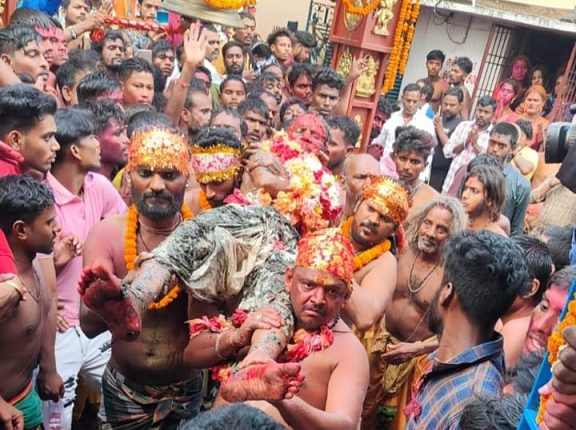‘Danda Nacha’ Concludes With Final Offering In Odisha’s Ganjam

Berhampur: The sound of drums, cymbals and conch shells that reverberated in the air for last 21 days for ‘Danda Nacha’ across Ganjam district in Odisha culminated with final offering to the Goddess on the occasion of “Maha Bishuba Sankranti” on Sunday.
People in large number gathered at Danda Kali temples in the district to take part in the rituals on the concluding day of Danda Yatra. The festivities on this day are called ‘Meru Jatra’. Maha Bishuba Sankranti, locally known as Meru Sankranti, marks the beginning of Odia New Year.
In Berhampur, ‘Meru Jatra’ was celebrated at Danda Kali temples at New Bus Stand, Panigrahipentha, Diamond Tank Road, Bijipur, Ambapua and Anand Sarani. Large crowd gathered in the areas to witness the final offering of ‘Pata Bhoktas’ who lead the ‘Danda Nacha’ troupes.
After ritualistic baths, the ‘Pata Bhoktas’ were led to the Danda Kali temples by other ‘Danduas’. The ‘Pata Bhoktas’ were blind-folded and their bodies smeared with a special paste prepared from turmeric and other herbs. Then they were hung upside down above a pit of fire. They remained in that condition till three drops of blood fell from their nostrils into the fire.
The Bhoktas or Danduas, who take up life of hard penance for three weeks and become members of ‘Danda Nacha’ troupes, ended their period of austerity on this day. They had left the comfort of their homes to take up the penance in honour of Goddess ‘Danda Kali’ during the period. After ‘Meru Jatra’, they would return to their homes.
The Danda Nacha is performed in Ganjam in Odia month of ‘Chaitra’ and boasts of a pristine heritage. It begins 13, 18 or 21 days before ‘Bisuba Sankranti’ and culminates on ‘Meru Sankranti’. Historians trace its origin to 8th and 9th century (time of inception of Tantrism) after the decadence of Buddhism in Odisha.
The ‘Danduas’ undergo a lot of pain and hardship to appease the Goddess while others do it to show their gratitude to the Goddesses for having fulfilled their desires and pre-ordained vows or ‘Manasikas’.
The Danduas generally stay near a temple or some sacred place, away from their families, to concentrate on worshiping during the entire period. They move out in the morning amid beating of drums and blowing of conch and trumpet.
When they move in rows with red and yellow flags, the locals seek their blessings. Danduas perform on the streets and in front of one house on request. The dance takes place in groups consisting of 40 to 100 ‘Danduas’. The head of the group is called ‘Bada Patta Dandua’ or ‘Bada Patta Bhukta’.
The dance group is carefully selected. There is a strict dress code with only white, yellow or saffron cloth being used. The deities are carried in a small red box and fanned by peacock plumes. The ‘Danduas’ eat only once in a day and do not even take water till ‘Pani Danda’ in the evening. Although the dance is ritualistic, there is no caste bar for participants.

Comments are closed.